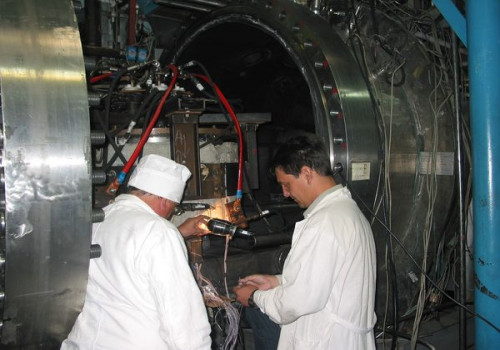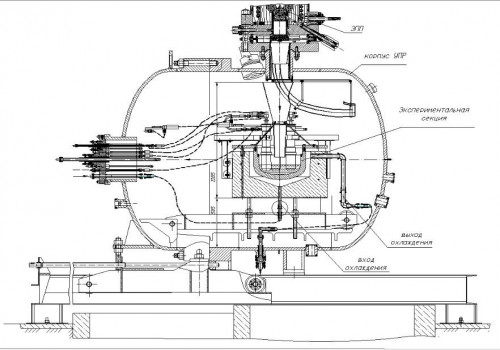COMPLEX OF STUDIES IN SUBSTANTIATION OF MATERIALS SELECTION FOR SUB-REACTOR EMERGENCY CORE MELT CATCHER
23 May 2022


30 Projects to the 30th Anniversary of NNC RK!
Project # 18. 2012–2021. COMPLEX OF STUDIES IN SUBSTANTIATION OF MATERIALS SELECTION FOR SUB-REACTOR EMERGENCY CORE MELT CATCHER
CORMIT (Corium and Refractory Materials Interaction Test – experiment for corium-refractory material interaction) is a project, aimed at experimental study of corium-refractory material interaction proposed for the protective coating of the sub-reactor core melt catcher. The studies mentioned were carried out by the National Nuclear Center of the Republic of Kazakhstan by the order of TOSHIBA company. Such experimental studies enable to conduct a reasonable selection of an effective refractory material to cover designed sub-reactor core melt catcher, meant to increase NPP safety, in case of severe core melt accident. Studies have been carried out at the NNC experimental base – HPG-135 and “Lava-B” facilities. The CORMIT project has been implemented in cooperation with Marubeni Utility Services, Ltd. (MUS).
The experiments objective was to study the processes and consequences of corium (debris) interaction with coating material to choose the most efficient material for core melt catcher coating. As a result of the conducted experiments, parameters of refractory (protective) materials erosion under the corium impact were determined, as well as parameters of mechanical and thermal processes, occurring during corium contact with refractory material, data were obtained for verification of models and calculation codes, describing the process of corium-melt catcher interaction.
Large-scale experimental studies were realized at “Angara” test bench, located at the territory of technical zone of “Baikal-1” research reactor complex. The test bench includes “Lava-B” experimental facility meant for study the nature of melted fuel interaction with structural materials in conditions simulating core melt accident. “Lava-B” experimental facility consists of electric melt furnace (|EMF), melt receiving device (MRD) and technological systems.
Technological systems as a part of the bench, ensure the “Lava-B” operation and enable to conduct the following operations:
• materials composition heating and melting in EMF;
• melt (corium) discharge to the experimental device;
• video shooting of melt discharge process;
• gases (argon, nitrogen, helium, water vapor) feeding to the facility cavity;
• water (with the temperature up to 150°С) feeding to the corium catcher;
• automatic collection, processing and storage of experimental data and parameters recording (information-measuring system includes: 90 channels for statistical and 4 pulse pressure measuring, 180 channels of temperature measuring, two infrared temperature sensors (pyrometers), 28 sensors of water and vapor rates; it is possible to record parameters with a frequency of up to 15 measurements per a second);
• simulation of residual heat release in the melt;
• gas sampling from the facility. The bench enables to carry out a wide range of experimental studies on study the processes, typical for severe accidents at water cooled reactors using corium simulator.
The test bench enables to conduct tests pursuing the following purposes:
• study of thermo-physical and mechanical properties of corium of different composition;
• study of nuclear reactor structural materials behavior at their interaction with corium;
• study of corium behavior and its state when contacting the water (in the process of corium discharge to water pool or corium surface irrigation);
• study of construction and refractory protective materials behavior when contacting the corium.
Latest news by category:
-
Participation in IAEA International Fusion Research Council Meeting on Controlled Thermonuclear Fusion
25 December 2025
-
NNC RK Participated in CIS Commission Meeting on Peaceful Use of Atomic Energy
17 December 2025
-
Pivotal Role of Kazakhstan in Global Thermonuclear Fusion Research
17 December 2025
-
Enhancing Human Resources Development with Support of JAEA
09 December 2025